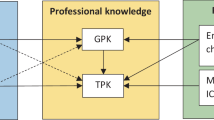Abstract
Using nationally representative data for lower secondary teachers from the 2013 Teaching and Learning International Survey, we examined differences in factors associated with technology-enabled learning between the United States and South Korea. The results confirmed the importance of teachers’ self-efficacy and their participation in professional development for technology-enabled learning in both countries. However, we found differences in the degree to which participation in professional development mattered to technology-enabled learning between the two countries. In addition, we found that cooperation and gender were significant predictors of technology-enabled learning in South Korea but not in the United States. By contrast, having constructivist beliefs was a significant predictor in the United States, but not in South Korea. The article goes on to highlight differences in information and communication technology policy environments between the United States and South Korea that may potentially explain these between-country differences in factors associated with technology-enabled learning.
Similar content being viewed by others
Notes
TALIS 2013 also surveyed teachers in elementary and upper secondary schools (OECD 2014a). However, in this study, we focused on the original target population (teachers and school leaders in lower secondary education).
It is important to note that the United States did not achieve an acceptable level of response, but the response rate and quality of data are nevertheless of sufficiently high quality to use. For more information about the US sample, please see http://nces.ed.gov/surveys/talis/talis2013/.
We also conducted ordered and multinomial regression by treating our dependent variable as an ordinal and categorical variable, respectively. However, we found few differences. Results from the ordered and multinomial analyses are available upon request from the authors.
References
Baek, Y. G., Jong, J., & Kim, B. (2008). What makes teachers use technology in the classroom? Exploring the factors affecting facilitation of technology with a Korean sample. Computers & Education, 50, 224–234.
Bandura, A. (1977). Self-efficacy: Toward a unifying theory of behavioral change. Psychologist, 37, 122–147.
Byun, S., Henck, A., & Post, D. (2014). Cross-national variations in student employment and academic performance: The roles of national context and international law. Comparative Education Review, 85(4), 621–652.
Ebner, M., Zechner, J., & Holzinger, A. (2006). Why is wikipedia so successful? Experiences in establishing the principles in higher education. In Proceedings of i-know (Vol. 6, pp. 527–535).
Eickelmann, B., & Vennemann, M. (2017). Teachers ‘attitudes and beliefs regarding ICT in teaching and learning in European countries. European Educational Research Journal, 16(6), 733–761.
Ertmer, P. A., & Ottenbreit-Leftwich, A. T. (2010). Teacher technology change: How knowledge, beliefs, and culture intersect. Journal of Research on Technology in Education, 42, 255–284.
Ertmer, P. A., & Ottenbreit-Leftwich, A. (2013). Removing obstacles to the pedagogical changes required by Jonassen’s vision of authentic technology-enabled learning. Computers & Education, 64, 175–182.
Ertmer, P. A., Ottenbreit-Leftwich, A. T., Sadik, O., Sendurur, E., & Sendurur, P. (2012). Teacher beliefs and technology integration practices: A critical relationship. Computers & Education, 59(2), 423–435.
Fößl, T., Ebner, M., Schön, S., & Holzinger, A. (2016). A field study of a video supported seamless-learning-setting with elementary learners. Educational Technology & Society, 19(1), 321–336.
Fraillon, J., Ainley, J., Schulz, W., Friedman, T., & Gebhardt, E. (2014). Preparing for life in a digital age: The IEA International Computer and Information Literacy Study international report. New York: Springer. https://doi.org/10.1007/978-3-319-14222-7.
Garet, M., Porter, A., Desimone, L., Briman, B., & Yoon, K. (2001). What makes professional development effective? Analysis of a national sample of teachers. American Educational Research Journal, 38(4), 915–945.
Hampden-Thompson, G., & Pong, S. (2005). Does family policy environment moderate the effect of single-parenthood on children’s academic achievement? A study of 14 European countries. Journal of Comparative Family Studies, 36(2), 227–248.
Hermans, R., Tondeur, J., van Braak, J., & Valcke, M. (2008). The impact of primary school teachers’ educational beliefs on the classroom use of computers. Computers & Education, 51(4), 1499–1509.
Hiebert, J., Gallimore, R., & Stigler, J. W. (2002). A knowledge base for the teaching profession: What would it look like and how can we get one? Educational Researcher, 31(5), 3–15.
Hsu, S., & Kuan, P. Y. (2013). The impact of multilevel factors on technology integration: The case of Taiwanese grade 1–9 teachers and schools. Educational Technology Research and Development, 61(1), 25–50.
Inan, F. A., & Lowther, D. L. (2010). Factors affecting technology integration in K-12 classrooms: A path model. Educational Technology Research and Development, 58(2), 137–154.
Johnson, D. R., & Young, R. (2011). Toward best practices in analyzing datasets with missing data: Comparisons and recommendations. Journal of Marriage and Family, 73, 926–945.
Jonassen, D. H., & Reeves, T. C. (1996). Learning with technology: using computers as cognitive tools. In D. H. Jonassen (Ed.), Handbook of research for educational communications and technology (pp. 693–719). New York: Macmillan.
Karaca, F., Can, G., & Yildirim, S. (2013). A path model for technology integration into elementary school settings in Turkey. Computers & Education, 68, 353–365.
KERIS (2013). 2013 white paper on ICT in education Korea. Daegu, Korea: Korea Education and Research Information Service, PM2013-3.
KERIS (2015). A Korean model for using ICT in education: Policy. Daegu, Korea: Korea Education and Research Information Service.
KERIS (2016). 2016 white paper on ICT education in Korea. Daegu, Korea: Korea Education and Research Information Service, PM2016-4.
Kim, C., Kim, M. K., Lee, C., Spector, J. M., & DeMeester, K. (2013). Teacher beliefs and technology integration. Teaching and Teacher Education, 29, 76–85.
Kopcha, T. J. (2012). Teachers’ perceptions of the barriers to technology integration and practices with technology under situated professional development. Computers & Education, 59(4), 1109–1121.
Law, N., Niederhauser, D. S., Christensen, R., & Shear, L. (2016). A multilevel system of quality technology-enhanced learning and teaching indicators. Educational Technology & Society, 19(3), 72–83.
Liu, F., Ritzhaupt, A. D., Dawson, K., & Barron, A. E. (2017). Explaining technology integration in K-12 classrooms: A multilevel path analysis model. Educational Technology Research and Development, 65(4), 795–813.
Liu, S.-H. (2011). Factors related to pedagogical beliefs of teachers and technology integration. Computers & Education, 56, 1012–1022.
Liu, S. H. (2013). Teacher professional development for technology integration in a primary school learning community. Technology, Pedagogy and Education, 22(1), 37–54.
Maio, G. R., & Olson, J. M. (1995). Relations between values, attitudes, and behavioral intentions: The moderating role of attitude function. Journal of Experimental Social Psychology, 31(3), 266–285.
McDaniel, A. (2010). Cross-national gender gaps in educational expectations: The influence of national-level gender ideology and education systems. Comparative Education Review, 54(1), 27–50.
OECD (2014a). TALIS 2013 results: An international perspective on teaching and learning. Paris: OECD Publishing. https://doi.org/10.1787/9789264196261-en.
OECD (2014b). TALIS 2013 technical report. OECD Publishing. Retrieved from http://www.oecd.org/edu/school/TALIS-technical-report-2013.pdf.
Office of Educational Technology (2010). Transforming American education: Learning powered by technology, the National Educational Technology Plan 2010. U.S. Department of Education. Retrieved from https://www.ed.gov/sites/default/files/netp2010.pdf on May, 2017.
Office of Educational Technology (2017). Reimagining the role of technology in education. US Department of education: 2017 National education technology plan update. U.S. Department of Education. Retrieved from https://tech.ed.gov/files/2017/01/NETP17.pdf.
Ottenbreit-Leftwich, A. T., Ertmer, P. A., & Tondeur, J. (2015). Interpretation of Research on Technology integration in teacher education in the USA: Preparation and current practices. In P. Smeyers, D. Bridges, N. C. Burbules, & M. Griffiths (Eds.), International handbook of interpretation in educational research (pp. 1239–1262). Dordrecht: Springer.
Park, H., & Byun, S. (2015). Why some countries attract high-ability young students to teaching: Cross-national comparisons of students’ expectation to become a teacher. Comparative Education Review, 59(3), 523–549.
Perrotta, C. (2013). Do school-level factors influence the educational benefits of digital technology? A critical analysis of teachers’ perceptions. British Journal of Educational Technology, 44(2), 314–327.
Raudenbush, S. W., & Bryk, A. S. (2002). Hierarchical linear models: Applications and data analysis methods (2nd ed.). Thousand Oaks: Sage Publications.
Richter, D., Kunter, M., Klusmann, U., Lüdtke, O., & Baumert, J. (2011). Professional development across the teaching career: Teachers’ uptake of formal and informal learning opportunities. Teaching & Teacher Education, 27(1), 116–126.
Rogers, W. (1993). Regression standard errors in clustered samples. Stata Technical Bulletin, 13, 19–23.
Schleicher, A. (2011). Lessons from the world on effective teaching and learning environments. Journal of Teacher Education, 62(2), 202–221.
Schrum, L., Dolan, R., Ifenthaler, D., Huang, R., Niederhauser, D., & Strudler, N. (2014). Competencies, challenges, and changes: A global conversation about 21st century teachers and leaders. CELDA, 3.
Severin, E., & Capota, C. (2011). The use of technology in education: Lessons from South Korea. IDB Education, 10, 1–8.
Shin, W. S. (2015). Teachers’ use of technology and its influencing factors in Korean elementary schools. Technology, Pedagogy and Education, 24(4), 461–476.
Shin, W. S., Han, I., & Kim, I. (2014). Teachers’ technology use and the change of their pedagogical beliefs in Korean educational context. International Education Studies, 7(8), 11–22.
So, H.-J., Choi, H., Lim, W. Y., & Xiong, Y. (2012). Little experience with ICT: Are they really the net generation student-teachers? Computers & Education, 59, 1234–1245.
Tezci, E. (2011). Turkish primary school teachers’ perceptions of school culture regarding ICT integration. Educational Technology Research and Development, 59(3), 429–443.
Tondeur, J., van Braak, J., Ertmer, P. A., & Ottenbreit-Leftwich, A. (2017). Understanding the relationship between teachers’ pedagogical beliefs and technology use in education: A systematic review of qualitative evidence. Educational Technology Research and Development, 65(3), 555–575.
van Braak, J., Tondeur, J., & Valcke, M. (2004). Explaining different types of computer use among primary school teachers. European Journal of Psychology of Education, 19(4), 407–422.
Vanderlinde, R., Van Braak, J., & Tondeur, J. (2010). Using an online tool to support school-based ICT policy planning in primary education. Journal of Computer Assisted Learning, 26(5), 434–447.
Vongkulluksn, V. W., Xie, K., & Bowman, M. A. (2018). The role of value on teachers’ internalization of external barriers and externalization of personal beliefs for classroom technology integration. Computers & Education, 118, 70–81.
Wong, E. M., & Li, S. C. (2011). Framing ICT implementation in a context of educational change: A structural equation modelling analysis. Australasian Journal of Educational Technology, 27(2), 361–379.
Yang, S. C., & Liu, S. F. (2004). Case study of online workshop for the professional development of teachers. Computers in Human Behavior, 20(6), 733–761.
Acknowledgements
Soo-yong Byun acknowledges support by the Ministry of Education of the Republic of Korea and the National Research Foundation of Korea (NRF-2017S1A3A2066878). The views expressed in this article are those of the authors and do not necessarily reflect those of the granting agency.
Funding
Soo-yong Byun acknowledges support by the Ministry of Education of the Republic of Korea and the National Research Foundation of Korea (NRF-2017S1A3A2066878).
Author information
Authors and Affiliations
Corresponding author
Ethics declarations
Conflict of interest
The authors declare that they have no conflict of interest.
Rights and permissions
About this article
Cite this article
Han, I., Byun, Sy. & Shin, W.S. A comparative study of factors associated with technology-enabled learning between the United States and South Korea. Education Tech Research Dev 66, 1303–1320 (2018). https://doi.org/10.1007/s11423-018-9612-z
Published:
Issue Date:
DOI: https://doi.org/10.1007/s11423-018-9612-z




